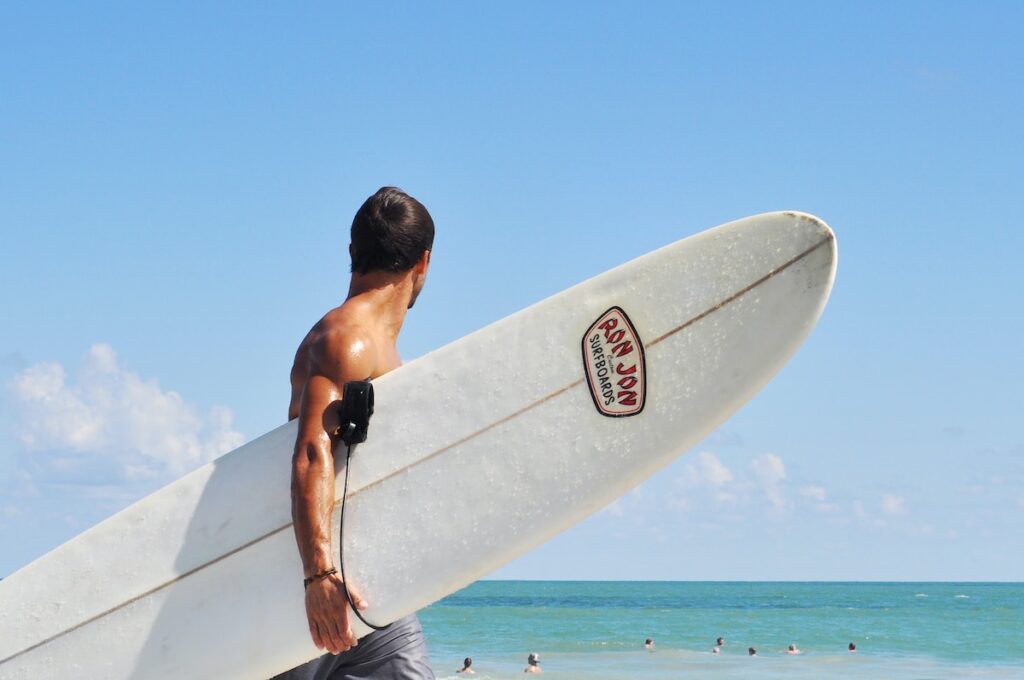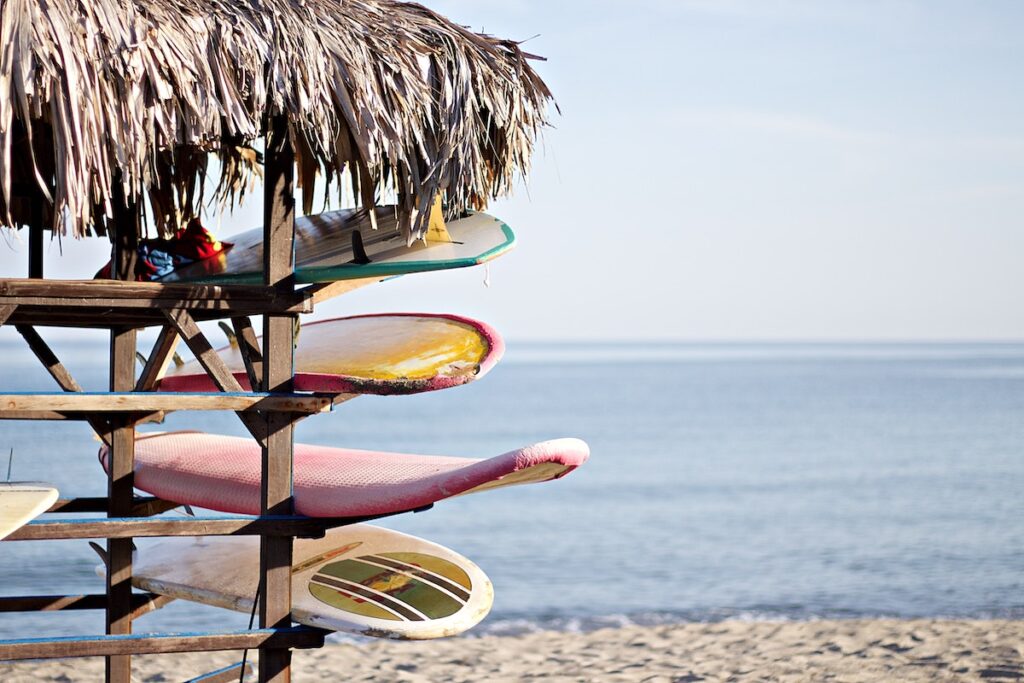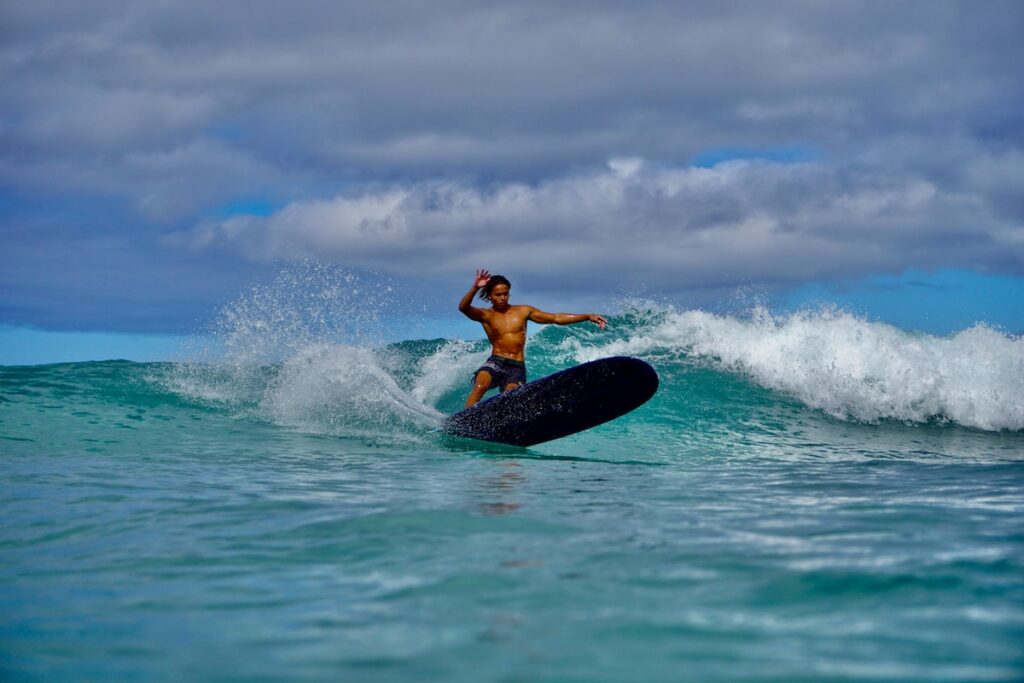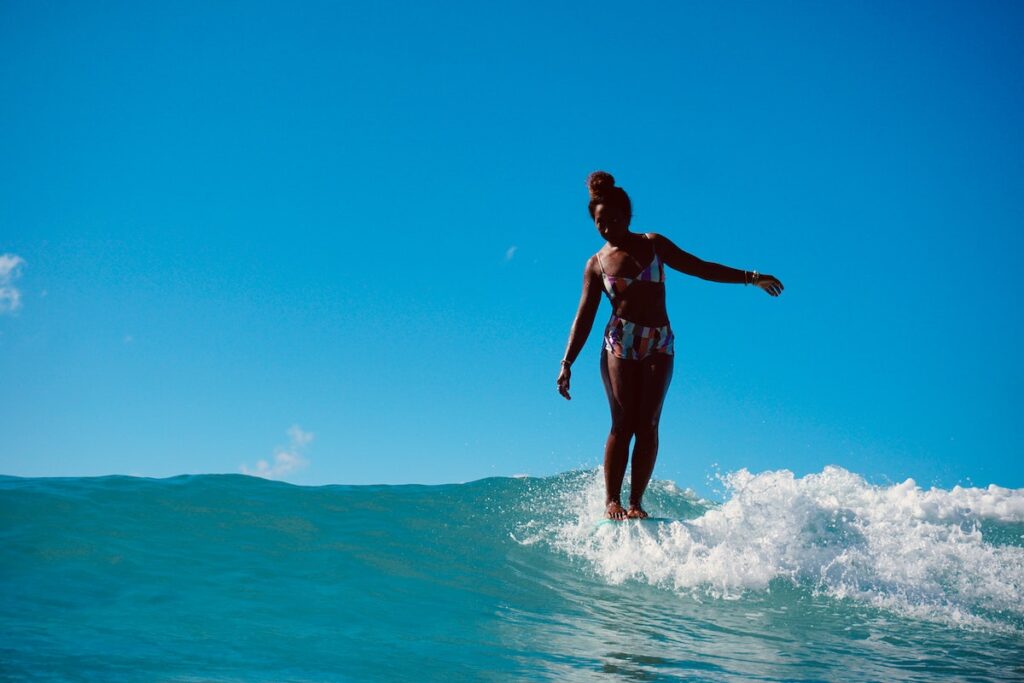14 Jun Longboard Surfing Tips for Beginners
Keen to try longboard surfing for the first time? We spoke to our surf coaching team in Costa Rica about getting a few longboard surfing tips. Here’s what they came up with!

Riding a longboard is one of the greatest pleasures in life.
They’re a breeze to paddle and infinitely easier to catch waves on compared to a shortboard.
Plus, you can surf even when the conditions are small, which means lots of beginners start their learn-to-surf journey on a longboard.
Let’s not forget that watching an experienced longboard surfer cross step up the length of the board looks super cool.
That being said, longboards can be unwieldy for a beginner surfer.
They’re long, wide and heavy to carry.
You can also feel like you’re paddling a boat given their surface area and size.
But don’t let this put you off learning to surf on a longboard.
Instead, use the following information and tips in this blog post to kickstart your longboard surfing experience!
What equipment do you need for longboard surfing?
Is it easy to surf on a longboard?
How long does it take to get good at surfing a longboard ?
Aren’t longboard surfboards harder to turn?
Should I learn to surf on a longboard?
5 essential longboard surfing tips
Practice your longboard popup technique on land
Choose the correct conditions to surf
What is a longboard?

We covered almost everything you need to know about buying your first longboard previously in a popular blog article.
To recap though, a longboard is any board that’s ridden at a length roughly 3 or more feet taller than the rider. (9’+ are considered longboards, 7′-8’9 are considered “fun boards or mini-malibus”
There are many different types of longboard, such as foamies, logs, noseriders and mini-malibus. However, they all have a rounded nose, wide decks and additional thickness for more stability and buoyancy.
For these reasons, a longboard offers a more mellow and some may say nuanced riding experience compared to shortboards.
They’re also the board of choice for those of you who are just starting out with surfing.
What equipment do you need for longboard surfing?
If you want to learn to surf in a tropical destination like Costa Rica, all you need for a longboard surf session is wax, a leash and a fin.
The wax needs to be suitable for tropical conditions in order to be effective. As for the leash or legrope, it should be strong enough to bear the strain of a longboard without snapping.
The leash should has the same lenght as the longboard, to prevent the board “springing” back to you if you fall and the wave keeps taking the board away from you until the leash brings it back to you.
Of course, this might sound like a lot to remember, but you’ll be happy to know we have our own supply of longboards, leashes, wax and fins for you to use at our surf retreat, which means you don’t need to bring your own.
Plus, everything is prepared before your arrival (fresh coat of wax, the right leash for the reight board, for the right guest).
Is it easy to surf on a longboard?
Yes!
If you want to learn how to surf properly, a longboard is the easiest and fastest way to master the basics.
They’re stable and user-friendly which makes them wave-catching machines.
Longboards are also more robust than toothpick-like shortboards, so you don’t need to worry (too much) about snapping one.
(Unless a big wave breaks right on your board… so make sure you understand where is the impact zone and “When the waves breaks here, don’t be there!”)
How long does it take to get good at surfing a longboard ?
This is a hard question to answer.
It really depends on the person and the waves that they have access to.
Someone who is practicing every day on perfect longboard waves like the ones where we host our surf retreats can learn the fundamentals in one week with no problem.
On the flip side, it’s hard to make any long-lasting progress if you’re only surfing a few times a month or less.
This is one of the reasons why we recommend booking a surf coaching retreat with us in Costa Rica.
Aren’t longboard surf boards harder to turn?
Yes and no.
If you’ve never turned a surfboard before, you might be surprised to learn that longboard surfboards aren’t all that difficult to turn, so long as you don’t expect to make fast direction changes.
As for the best technique involved in turning a longboard, we will teach you that once you progress past the beginner surfer stage and move into intermediate territory.

Should I learn to surf on a longboard?
Whenever any asks us if they should learn to surf on a longboard, our answer is always “Hell yes”!
Like we said earlier, longboarding is easy to pick up under the right guidance.
What we didn’t mention though is that due to the relatively simple learning curve, it’s also really fun.
After all, the last thing we want is for your very first surf session to be a bummer.
By taking a longboard out for a surf and studying from our resident experts, you can learn surfing faster and feel 100% safe doing so.
5 essential longboard surfing tips

When we mention longboard surf tips, what we’re really talking about are tips for beginner surfers that are starting out on a longboard.
So while the following tips might not have you cross-stepping like a pro, they’ll definitely give you a good foundation to build upon.
They’re also really great if you want to hit the ground running (or hit the wave riding in this case) upon rocking up to our surf retreats.
And if you already surf and need help to decide what to buy as a first longboard, check out our guide to buy your first longboard.
With that in mind, it’s time to fast-track your learn-to-surf longboard journey by checking out these essential tips today.
Tip #1: Practice your longboard popup technique on land
It seems that we can’t mention beginner surf tips without also discussing the now-famous popup.
In case you didn’t know, the popup is the name of the movement that takes you from a prone (lying down) to a standing position on your surfboard.
Essentially, a good popup technique is the difference between your first green wave and the wipeout of a lifetime, so if you want to make the most of your longboard surf session, you need to have your popup locked down.
This is way easier than you might think. Chiefly because you can practice your popup technique at home.
Here’s how to do it.
- Lie face down on your mat or towel
- Place your hands palm side down in line with your ribs
- Extend your arms so you come into an upward dog yoga pose
- Bring your back foot (left for goofy stance/right for regular stance) to the tail area of your longboard
- Push off this foot and your hands to create space between your body and the board
- Swing your front foot (right for goofy stance/left for regular stance) through the arch between your arms while keeping your butt as low as possible
- Find your center of balance and rise up slowly whilst keeping your knees bent and your lower back relatively straight
- Congratulations! You just nailed a longboard popup
Tip #2: Choose the correct conditions to surf
While it might not be an oft-talked-about tip, the conditions in which you surf play a massive role in determining how you perform during a longboard surf session.
Even a confident beginner or intermediate surfer with a few lessons under their belt can flounder in less than ideal conditions. Conversely, a first timer can thrive if the waves are just right.
For this reason, we suggest you seek out longboard-friendly waves.
This means any wave that rolls towards the beach before crumbling and peeling or creating a gentle wall of whitewash that can be caught.
What we don’t recommend riding are any waves that break right on the shore, dump onto a shallow sandbank or are packed with other surfers, but we’ll talk more about that in a second.
Also, it pays to be cautious no matter what size board you’re riding.
If the conditions look sketchy or there are no other surfers in the water, you might want to wait it out to get a better idea of the conditions.
Oh… and if you see anyone walking back up the beach with a snapped surfboard, it’s probably best to try again another day.
Tip #3: Keep your distance from the main crowd
There are generally more people in the water when the waves are small.
Coincidentally, small waves are the ideal practice ground for you to surf longboard style.
In our experience, the combination of large groups of people and varying skill levels can lead to embarrassing and sometimes dangerous incidents.
Boards might be bailed on a set wave. People will probably be dropping in on each other. There could even be collisions that result in dinged boards or bodies.
If you want our advice, it’s best not to contribute to this chaos unless you’re surfing under the supervision of an experienced coach or guide.
If there’s only one place to surf on the entire beach though, try to keep your distance from the main pack.
Always paddle around the lineup instead of straight through it and sit a little bit wide of the peak.
Better yet, you could scout for a more mellow place to surf if there are multiple options along the beach.
Tip #4: Don’t bend at the waist
When standing on a surfboard, you might feel compelled to get lower to the board in order to find a better sense of balance.
This is ok.
What doesn’t work so well is if you get lower to your board by bending at the waist.
Otherwise known as breaking at the waist or folding at the waist, it’s a balance-altering habit that should be corrected as soon as you realize you’re doing it.
Bending at the waist (when either going straight on your longboard or attempting a turn) actually leads to a poorer sense of balance which makes you more likely to fall.
Instead, always bend at the knees and keep your lower body compressed.
Any turn, no matter how slight, always comes from fixing your eyes on where you want to go, rotating the hips and applying pressure to your toe side or your heel side.
Of course, most new longboard surfers might overlook this tip since your balance while going straight on a longboard isn’t tested to its full extent.
When you do progress and become more interested in making directional changes or even maneuvers, you will need to keep your feet shoulder-width apart with both the rear foot and the front foot forward over the stringer.
Then, simply keep those knees bent and control your board by looking where you want to go and allowing your hips and lower body to follow that line.
Tip #5: Book a surf retreat to improve your longboarding skills
If you really want to learn the fundamentals of surfing and become a confident surfer, there really is only one solution – book a surf retreat so you can practice every day!
With perfect waves at our doorstep and a variety of surf breaks to choose from, our rustic yet comfortable surf resort has everything you need to make fast progress in the water.
We take small-batch classes (3-4 people max) so you get direct and highly personalized feedback from your coaches.
Plus, we have a great selection of longboards for you to practice on, which means you don’t need to buy one before you come or spend extra money renting a board upon arrival.
The fact that you can enjoy two surf sessions every day is also incredibly helpful since it gives most surfers ample opportunity to refine their technique and correct poor habits.
So, if your ultimate goal is to learn to surf the right way and build a solid foundation from which to further your surf skills, you’ve come to the right place.
Surf Expedition is the number one rated surf retreat on Trip Advisor with dozens of positive reviews from happy guests.

Book your next learn-to-surf adventure with us today!
